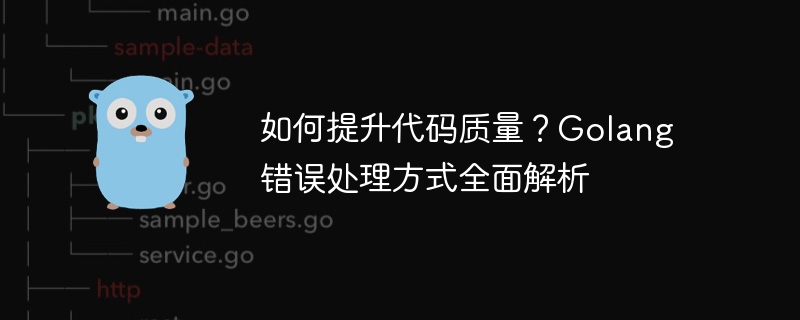Home >Backend Development >Golang >How to improve code quality? Comprehensive analysis of Golang error handling methods
How to improve code quality? Comprehensive analysis of Golang error handling methods
- WBOYWBOYWBOYWBOYWBOYWBOYWBOYWBOYWBOYWBOYWBOYWBOYWBOriginal
- 2024-03-14 10:48:041002browse

Improving code quality has always been one of the topics that programmers are very concerned about. As an important part of code quality, error handling is also one of the parts that needs to be focused on and improved. This article will take Golang as an example to comprehensively analyze how to improve code quality, especially in terms of error handling, through specific code examples.
Error handling is very important in programming. It can help the program handle appropriately when abnormal situations occur and avoid program crashes or unpredictable errors. In Golang, error handling uses the "error" type to represent errors and passes the error to the caller by returning a value. Let's look at a simple example to illustrate the basic usage of error handling:
package main
import (
"errors"
"fmt"
)
func divide(a, b int) (int, error) {
if b == 0 {
return 0, errors.New("被除数不能为0")
}
return a / b, nil
}
func main() {
result, err := divide(10, 0)
if err != nil {
fmt.Println("发生错误:", err)
return
} else {
fmt.Println("结果为:", result)
}
}In the above code, we define a divide function to find the quotient of two integers , if the divisor is 0, an error is returned. In the main function, we call the divide function and determine whether the returned error is nil. If it is not nil, the error message is output, otherwise the calculation result is output.
In addition to basic error handling, Golang also provides some more advanced error handling methods, such as using the defer keyword to handle errors, and using panic and The recover mechanism handles errors, etc. Let's look at an example of using defer to handle errors:
package main
import (
"fmt"
)
func readFile(fileName string) error {
file, err := os.Open(fileName)
if err != nil {
return err
}
defer file.Close()
// 读取文件内容
// ...
return nil
}
func main() {
err := readFile("test.txt")
if err != nil {
fmt.Println("读取文件出错:", err)
}
} In the above example, we use the defer keyword to close the file when the function returns, even if You can also ensure that the file is closed correctly if an error occurs during function execution, thereby avoiding resource leaks.
In addition, Golang also provides panic and recover mechanisms for handling serious errors. The panic function is used to trigger a runtime panic, while the recover function is used to capture the panic caused by panic and process it. Here is a simple example:
package main
import (
"fmt"
)
func recoverFromPanic() {
if r := recover(); r != nil {
fmt.Println("发生严重错误:", r)
}
}
func doSomething() {
defer recoverFromPanic()
panic("发生严重错误")
}
func main() {
doSomething()
fmt.Println("程序结束")
} In the above code, we use the panic function to cause a panic in the doSomething function and in the recoverFromPanic Use the recover function to capture and handle panics. In this way, we can deal with panic in time when it occurs and ensure that the program continues to run normally.
To sum up, one of the keys to improving code quality in Golang is to strengthen error handling. By correctly handling errors, the program can be made more robust and stable. In addition to basic error handling, reasonable use of mechanisms such as defer, panic, and recover can also help us better handle various abnormal situations. Through continuous practice and learning, we can gradually improve the quality of code and write more elegant and stable code.
The above is the detailed content of How to improve code quality? Comprehensive analysis of Golang error handling methods. For more information, please follow other related articles on the PHP Chinese website!

